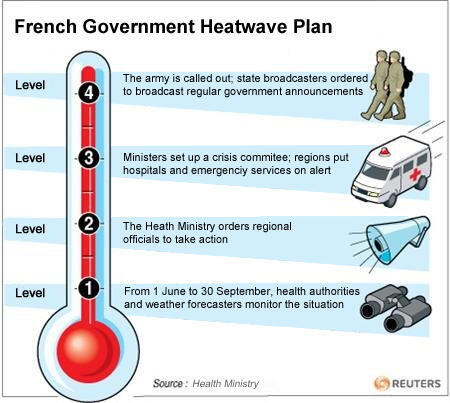Paris transport guide: how to keep your cool during the heatwave
Anyone who’s endured a Paris metro ride in the peak of the summer tourist season will know the sticky, stuffy discomfort that comes with the experience. With this week’s heatwave about to send the mercury nudging 40 degrees, RFI has these tips for keeping your cool while zipping about the capital.
Issued on: Modified:

Parisians will be trading their umbrellas for parasols as the rare June heatwave drives away the turbulent storms that have marked much of the past month.
It’s going to feel like 40 degrees in the shade, Météo France weatherman Emmanuel Demaël tells us, so surely enclosed spaces packed with thirsty, flustered commuters are to be feared and avoided?

Not necessarily. While it’s no secret that air-conditioning in Paris’s metro, trains and buses is far from widespread (and in restaurants, cafes, shops and even cinemas for that matter), it appears not all metro lines were created equal – and some, thanks to clever engineering, are cooler than others.
Metros and trams
Those bravingla canicule should prioritise the more recently refurbished lines 1, 2, 5, 9 and 14. However, strictly speaking they’re not “air-conditioned”; they are very energy-efficient and generate what’s called "refrigerated ventilation" throughout their expansive, winding subterranean passages.
Lines 3, 3 bis, 6, 10, 11 and 12 are the most likely to resemble furnaces. Of course the trains have “natural ventilation”, thanks to skylights on the roof, but during periods of extreme heat, it’s the unbreathable, hot and uncomfortable air that’s circulated.
One way to stay cool in the canicule, bring your own inflatable ring to the fountain... #heatwave #paris #canicule #placedesvosges pic.twitter.com/qXx7OG3z42
Sophie Gorman (@SophieTheGorman) 23 juin 2019
That leaves lines 4, 7, 7a, 8 and 13, which have what’s termed “forced mechanical ventilation”. This means air is sucked out and reinjected into the train, causing a slight draft of air that is sadly not fresh.
For those feeling particularly uncomfortable and heat-stressed, the best respite is to be found on Paris’s increasingly popular and increasingly extensive tram network.
With the exception of the T1 (which will be upgraded in 2022) Paris’s trams are new, and their comparatively efficient air-conditioning is a luxury in a city that struggles to keep its people cool.

Buses to be avoided
That brings us to RATP’s buses, 94 percent of which – alas – do not have air-conditioning. For this reason, bus drivers last year won the right to wear Bermuda shorts or skirts in the place of their trouser uniform.
The dearth of air-conditioned buses is about to become a thing of the past, with a fleet of fancy new cool buses set to enter service next year. The plan is for all 4,700 buses in Paris to be air-conditioned by 2025. It’s a step in the right direction, of course, but it won’t do much to ease the sweat and tears of passengers this week.
Suburban RERs hit and miss
Instead, a better bet would be the RER and inter-suburban trains, where overall you’ll have a one-in-two chance of finding air-con – unless you’re fortunate enough to be riding the RER A (Disneyland, anyone?), where all trains are equipped with the aforementioned refrigerated ventilation.
As is tradition during the more difficult summer days, RATP and SNCF staff will be handing out water bottles at major stations.
With a level 3 heatwave action plan in place in Paris this week, cool areas of respite will be provided for people at risk, such as babies and elderly people, while hospitals and emergency services will be on alert.

Daily newsletterReceive essential international news every morning
Subscribe